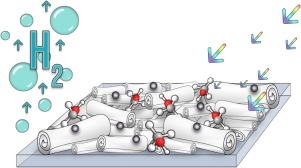Catalysis Today ( IF 5.2 ) Pub Date : 2018-06-26 , DOI: 10.1016/j.cattod.2018.06.029 Barbara N. Nunes , Christoph Haisch , Alexei V. Emeline , Detlef W. Bahnemann , Antonio Otavio T. Patrocinio

|
High efficient photocatalytic surfaces were obtained through the layer-by-layer (LbL) deposition of hexaniobate nanoscrolls on conductive glasses. These films were deposited by alternative immersions of the substrate into exfoliated hexaniobated suspensions (pH = 8) and poly(allylamine hydrochloride) solutions (pH = 4). The organic species were further removed by thermal treatment leading to a fuzzy assembly of hexaniobate nanoscrolls. Pre-adsorption of [Pt(NH3)4]2+ cations on the niobate layers allows the production of metallic Pt nanoclusters on the film layers. The Pt-modified films exhibited apparent quantum yields of (4.0 ± 0.5) % for H2 evolution from water/methanol mixtures under UV-A irraditation. The H2 evolution rates varied linearly with the number of deposited bilayers, indicating that no active sites are lost as the film is grown. The photoelectrochemical properties of the films reveal that the small size of the hole scavenger and its easy diffusion into the hexaniobate layers are key aspects for the photocatalytic activity. In the absence of alcohols as hole scavengers, irradiation of the hexaniobate LbL films in aqueous solutions leads to the production of surface-bound peroxides that limit the photocatalytic water splitting ability of these materials. The results presented here provide evidence for the effectiveness of the LbL technique to deposit thin films of layered materials retaining their interesting adsorption chemistry. This methodology can be further employed for the development of highly active photocatalytic surfaces.
中文翻译:

己酸铌纳米卷的层层薄膜的光催化性能
高效光催化表面是通过将得到的层-层上的导电眼镜hexaniobate纳米卷的(LBL)沉积。通过将基材交替浸入剥离的六铌悬浮液(pH = 8)和聚(烯丙胺盐酸盐)溶液(pH = 4)中,可以沉积这些薄膜。通过热处理进一步去除有机物,导致六铌酸盐纳米卷的模糊组装。在铌酸盐层上预吸附[Pt(NH 3)4 ] 2+阳离子可以在膜层上产生金属Pt纳米团簇。Pt改性的薄膜对H 2表现出(4.0±0.5)%的表观量子产率在UV-A照射下从水/甲醇混合物中释放出来。H 2析出速率随沉积双层数的增加而线性变化,表明随着薄膜的生长,没有活性位点损失。薄膜的光电化学性质表明,空穴清除剂的小尺寸及其易于扩散到己二酸酯层中是光催化活性的关键方面。在没有醇作为空穴清除剂的情况下,在水溶液中辐射六铌酸盐LbL膜会导致表面结合的过氧化物的产生,从而限制了这些材料的光催化水分解能力。此处给出的结果为LbL技术沉积分层材料薄膜保持其有趣的吸附化学作用的有效性提供了证据。该方法可以进一步用于开发高活性光催化表面。









































 京公网安备 11010802027423号
京公网安备 11010802027423号